Entry Database : PDB / ID : 2oz4Title Structural Plasticity in IgSF Domain 4 of ICAM-1 Mediates Cell Surface Dimerization FAB FRAGMENT LIGHT CHAIN FAB FRAGMENT, HEAVY CHAIN Intercellular adhesion molecule 1 Keywords / / / Function / homology Function Domain/homology Component
/ / / / / / / / / / / / / / / / / / / / / / / / / / / / / / / / / / / / / / / / / / / / / / / / / / / / / / / / / / / / / / / / / / / / / / / / / / / / / / / / / / / / / / / / / / / / / / / / / / / / / / / / / / / / / / / / / / / / / / / / / / / / Biological species Homo sapiens (human)Mus musculus (house mouse)Method / / / Resolution : 2.7 Å Authors Chen, X. / Kim, T.D. / Carman, C.V. / Mi, L. / Song, G. / Springer, T.A. Journal : Proc.Natl.Acad.Sci.Usa / Year : 2007Title : Structural plasticity in Ig superfamily domain 4 of ICAM-1 mediates cell surface dimerization.Authors : Chen, X. / Kim, T.D. / Carman, C.V. / Mi, L.Z. / Song, G. / Springer, T.A. History Deposition Feb 23, 2007 Deposition site / Processing site Revision 1.0 Oct 16, 2007 Provider / Type Revision 1.1 Jul 13, 2011 Group / Version format complianceRevision 2.0 Jul 29, 2020 Group Atomic model / Data collection ... Atomic model / Data collection / Derived calculations / Structure summary Category atom_site / chem_comp ... atom_site / chem_comp / entity / pdbx_branch_scheme / pdbx_chem_comp_identifier / pdbx_entity_branch / pdbx_entity_branch_descriptor / pdbx_entity_branch_link / pdbx_entity_branch_list / pdbx_entity_nonpoly / pdbx_nonpoly_scheme / pdbx_struct_assembly_gen / pdbx_struct_conn_angle / pdbx_struct_special_symmetry / struct_asym / struct_conn / struct_site / struct_site_gen Item _atom_site.auth_asym_id / _atom_site.auth_seq_id ... _atom_site.auth_asym_id / _atom_site.auth_seq_id / _atom_site.label_asym_id / _atom_site.label_entity_id / _chem_comp.name / _chem_comp.type / _entity.formula_weight / _entity.pdbx_description / _entity.pdbx_number_of_molecules / _entity.src_method / _entity.type / _pdbx_struct_assembly_gen.asym_id_list / _pdbx_struct_conn_angle.ptnr1_auth_seq_id / _pdbx_struct_conn_angle.ptnr1_label_asym_id / _pdbx_struct_conn_angle.ptnr2_label_asym_id / _pdbx_struct_conn_angle.ptnr3_auth_seq_id / _pdbx_struct_conn_angle.ptnr3_label_asym_id / _pdbx_struct_conn_angle.value / _pdbx_struct_special_symmetry.label_asym_id / _struct_conn.pdbx_dist_value / _struct_conn.pdbx_leaving_atom_flag / _struct_conn.pdbx_role / _struct_conn.ptnr1_auth_asym_id / _struct_conn.ptnr1_auth_seq_id / _struct_conn.ptnr1_label_asym_id / _struct_conn.ptnr1_label_seq_id / _struct_conn.ptnr2_auth_asym_id / _struct_conn.ptnr2_auth_seq_id / _struct_conn.ptnr2_label_asym_id Description / Provider / Type Revision 2.1 Aug 30, 2023 Group Data collection / Database references ... Data collection / Database references / Refinement description / Structure summary Category chem_comp / chem_comp_atom ... chem_comp / chem_comp_atom / chem_comp_bond / database_2 / pdbx_initial_refinement_model Item / _database_2.pdbx_DOI / _database_2.pdbx_database_accession
Show all Show less
 Yorodumi
Yorodumi Open data
Open data Basic information
Basic information Components
Components Keywords
Keywords CELL ADHESION /
CELL ADHESION /  IGSF DOMAIN /
IGSF DOMAIN /  STRUCTURAL PLASTICITY / CELL-SURFACE DIMERIZATION
STRUCTURAL PLASTICITY / CELL-SURFACE DIMERIZATION Function and homology information
Function and homology information phagocytosis, recognition / cellular response to interleukin-6 / establishment of endothelial barrier / response to copper ion / positive regulation of leukocyte adhesion to vascular endothelial cell / cell adhesion mediated by integrin / heterophilic cell-cell adhesion via plasma membrane cell adhesion molecules /
phagocytosis, recognition / cellular response to interleukin-6 / establishment of endothelial barrier / response to copper ion / positive regulation of leukocyte adhesion to vascular endothelial cell / cell adhesion mediated by integrin / heterophilic cell-cell adhesion via plasma membrane cell adhesion molecules /  phagocytosis, engulfment / leukocyte cell-cell adhesion / response to ionizing radiation / leukocyte migration / positive regulation of actin filament polymerization / immunoglobulin complex, circulating / cellular response to alkaloid / immunoglobulin receptor binding / plasma membrane => GO:0005886 / Interleukin-10 signaling / cellular response to nutrient levels / negative regulation of calcium ion transport /
phagocytosis, engulfment / leukocyte cell-cell adhesion / response to ionizing radiation / leukocyte migration / positive regulation of actin filament polymerization / immunoglobulin complex, circulating / cellular response to alkaloid / immunoglobulin receptor binding / plasma membrane => GO:0005886 / Interleukin-10 signaling / cellular response to nutrient levels / negative regulation of calcium ion transport /  immunological synapse /
immunological synapse /  regulation of immune response / response to amino acid / Integrin cell surface interactions / cellular response to interleukin-1 / negative regulation of endothelial cell apoptotic process / type II interferon-mediated signaling pathway /
regulation of immune response / response to amino acid / Integrin cell surface interactions / cellular response to interleukin-1 / negative regulation of endothelial cell apoptotic process / type II interferon-mediated signaling pathway /  complement activation, classical pathway / negative regulation of extrinsic apoptotic signaling pathway via death domain receptors / ovarian follicle development / positive regulation of vasoconstriction / response to amphetamine /
complement activation, classical pathway / negative regulation of extrinsic apoptotic signaling pathway via death domain receptors / ovarian follicle development / positive regulation of vasoconstriction / response to amphetamine /  antigen binding / cellular response to leukemia inhibitory factor / extracellular matrix organization / cellular response to dexamethasone stimulus / cellular response to glucose stimulus / sensory perception of sound / B cell receptor signaling pathway / response to insulin / positive regulation of GTPase activity / cytokine-mediated signaling pathway / cellular response to amyloid-beta / positive regulation of nitric oxide biosynthetic process / Immunoregulatory interactions between a Lymphoid and a non-Lymphoid cell / Interferon gamma signaling / positive regulation of peptidyl-tyrosine phosphorylation / transmembrane signaling receptor activity /
antigen binding / cellular response to leukemia inhibitory factor / extracellular matrix organization / cellular response to dexamethasone stimulus / cellular response to glucose stimulus / sensory perception of sound / B cell receptor signaling pathway / response to insulin / positive regulation of GTPase activity / cytokine-mediated signaling pathway / cellular response to amyloid-beta / positive regulation of nitric oxide biosynthetic process / Immunoregulatory interactions between a Lymphoid and a non-Lymphoid cell / Interferon gamma signaling / positive regulation of peptidyl-tyrosine phosphorylation / transmembrane signaling receptor activity /  integrin binding / virus receptor activity /
integrin binding / virus receptor activity /  signaling receptor activity / cellular response to tumor necrosis factor / positive regulation of NF-kappaB transcription factor activity / regulation of cell shape / cellular response to hypoxia / collagen-containing extracellular matrix / response to ethanol / Interleukin-4 and Interleukin-13 signaling / cellular response to lipopolysaccharide / receptor-mediated virion attachment to host cell / positive regulation of ERK1 and ERK2 cascade /
signaling receptor activity / cellular response to tumor necrosis factor / positive regulation of NF-kappaB transcription factor activity / regulation of cell shape / cellular response to hypoxia / collagen-containing extracellular matrix / response to ethanol / Interleukin-4 and Interleukin-13 signaling / cellular response to lipopolysaccharide / receptor-mediated virion attachment to host cell / positive regulation of ERK1 and ERK2 cascade /  cell adhesion / defense response to bacterium /
cell adhesion / defense response to bacterium /  membrane raft / external side of plasma membrane /
membrane raft / external side of plasma membrane /  focal adhesion /
focal adhesion /  innate immune response /
innate immune response /  cell surface /
cell surface /  extracellular space / extracellular exosome /
extracellular space / extracellular exosome /  membrane /
membrane /  plasma membrane
plasma membrane
 Homo sapiens (human)
Homo sapiens (human)
 Mus musculus (house mouse)
Mus musculus (house mouse) X-RAY DIFFRACTION /
X-RAY DIFFRACTION /  SYNCHROTRON /
SYNCHROTRON /  MOLECULAR REPLACEMENT / Resolution: 2.7 Å
MOLECULAR REPLACEMENT / Resolution: 2.7 Å  Authors
Authors Citation
Citation Journal: Proc.Natl.Acad.Sci.Usa / Year: 2007
Journal: Proc.Natl.Acad.Sci.Usa / Year: 2007 Structure visualization
Structure visualization Molmil
Molmil Jmol/JSmol
Jmol/JSmol Downloads & links
Downloads & links Download
Download 2oz4.cif.gz
2oz4.cif.gz PDBx/mmCIF format
PDBx/mmCIF format pdb2oz4.ent.gz
pdb2oz4.ent.gz PDB format
PDB format 2oz4.json.gz
2oz4.json.gz PDBx/mmJSON format
PDBx/mmJSON format Other downloads
Other downloads https://data.pdbj.org/pub/pdb/validation_reports/oz/2oz4
https://data.pdbj.org/pub/pdb/validation_reports/oz/2oz4 ftp://data.pdbj.org/pub/pdb/validation_reports/oz/2oz4
ftp://data.pdbj.org/pub/pdb/validation_reports/oz/2oz4 Links
Links Assembly
Assembly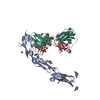
 Components
Components

 Homo sapiens (human) / Gene: ICAM1 / Production host:
Homo sapiens (human) / Gene: ICAM1 / Production host: 
 Cricetulus griseus (Chinese hamster) / Strain (production host): CHINESE HAMSTER CHO.LEC3.2.8.1 / References: UniProt: Q5NKV7, UniProt: P05362*PLUS
Cricetulus griseus (Chinese hamster) / Strain (production host): CHINESE HAMSTER CHO.LEC3.2.8.1 / References: UniProt: Q5NKV7, UniProt: P05362*PLUS Fragment antigen-binding
Fragment antigen-binding
 Mus musculus (house mouse) / References: UniProt: Q58EU4
Mus musculus (house mouse) / References: UniProt: Q58EU4 Fragment antigen-binding
Fragment antigen-binding
 Mus musculus (house mouse) / References: UniProt: P01757
Mus musculus (house mouse) / References: UniProt: P01757
 / Mass: 367.349 Da / Num. of mol.: 1
/ Mass: 367.349 Da / Num. of mol.: 1 N-Acetylglucosamine
N-Acetylglucosamine

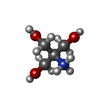




 Sulfate
Sulfate Tris
Tris Water
Water X-RAY DIFFRACTION / Number of used crystals: 1
X-RAY DIFFRACTION / Number of used crystals: 1  Sample preparation
Sample preparation
 SYNCHROTRON / Site:
SYNCHROTRON / Site:  APS
APS  / Beamline: 19-ID / Wavelength: 0.97949 Å
/ Beamline: 19-ID / Wavelength: 0.97949 Å : 0.97949 Å / Relative weight: 1
: 0.97949 Å / Relative weight: 1  Processing
Processing :
:  MOLECULAR REPLACEMENT
MOLECULAR REPLACEMENT Movie
Movie Controller
Controller



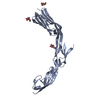




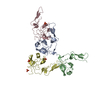


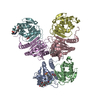
 PDBj
PDBj












